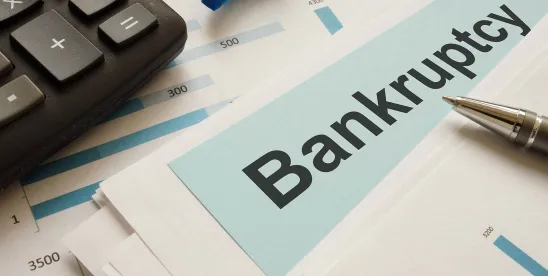Bankruptcy filings affect businesses across America.
The Bankruptcy Code is complex and difficult to navigate. But used properly, it can help creditors to minimize losses when a customer files bankruptcy. This article will guide you on how to stay out of trouble and improve your chances of getting paid by a bankrupt customer.
What Does the Bankruptcy Filing Mean?
The Bankruptcy system serves three basic purposes: It (i) provides a single forum to deal with the assets and liabilities of an insolvent debtor, (ii) provides the honest, but unfortunate, debtor with a "fresh start," and (iii) if a debtor chooses to reorganize its debts, it provides a process for saving and preserving the going-concern value of a business.
Bankruptcy has different chapters depending on the debtor's objectives. Chapter 7 is liquidation. A trustee is appointed to take control of and sell the debtor's property. Typically, the Customer's assets will be surrendered to those creditors holding security interests sold by the trustee to generate proceeds for distribution to creditors. Individuals or businesses may file Chapter 7, but only individuals can obtain a discharge of their debts.
Chapter 13 is called the "wage-earner" filing, and it's available to individuals only. In a Chapter 13, the debtor keeps his or her assets and proposes a three to five-year payment plan. Depending on several factors, including the debtor's income and available assets and whether you are a secured or unsecured creditor, recovery can vary. Similar to Chapter 7, Chapter 13 has a trustee. But his or her role is to be a monitor and conduit for distributing plan payments to creditors.
Chapter 11 bankruptcy is a reorganization proceeding available to businesses and wealthier individuals whose debt levels exceed the less burdensome Chapter 13 requirements. Similar to Chapter 13 cases, the Customer will file a plan of reorganization outlining the Customer's proposal to modify and repay debts. However, in Chapter 11 cases, creditors generally take a more active role in the proceeding and plan approval process to ensure that their rights are preserved and not adversely affected by the Customer's proposed plan. Once a plan has been approved by the Bankruptcy Court, payments are made pursuant to its terms.
The Automatic Stay
Immediately upon the Customer's bankruptcy filing, a substantial impact on a creditor's ability to exercise its rights is imposed. The "automatic stay" provision of the Bankruptcy Code stops creditors in their tracks from virtually any collection activity against Customer, providing Customer with room to reorganize its debts without the threat of collection actions from their creditors.
Any action to collect the balance of the money the Customer owes or to recover the property now under the protection of the Bankruptcy Court is considered a violation of the stay. Similarly, actions to obtain, perfect, or enforce a lien on property of the bankruptcy estate are prohibited. Further, if the Customer files under Chapter 13 and the debt owed is a "consumer debt" (i.e., a debt incurred for personal, as opposed to business, needs), the "co-debtor stay" prevents actions to collect from individuals jointly liable with Customer on that debt, even if they have not filed their own bankruptcy case.
In light of the automatic stay, proceeding with great caution is of the utmost importance. In the event of willful violations of the automatic stay, the Customer may be awarded sanctions against the creditor, including payment of fines, the Customer's attorneys' fees, and/or the creditor losing rights in the bankruptcy case itself. If you receive notice that the Customer is seeking sanctions for your violation of the automatic stay, quickly seek the assistance of knowledgeable legal counsel to minimize your exposure.
Payment Rights and Other Remedies
In certain instances, you may be entitled to "relief" from the automatic stay. If relief is granted by the Bankruptcy Court, creditors may proceed with taking those actions initially prohibited at the outset of the bankruptcy case. For example, a creditor may be able to obtain relief and file suit against a non-filing individual that was once protected by the co-debtor stay, in order to preserve its rights and increase the likelihood of payment on the delinquent account.
If it is customary for you to sell goods on credit, and if goods were sold to Customer within 45 days immediately preceding the bankruptcy filing, you may be able to reclaim the goods from the Customer. You may also be entitled to assert an administrative priority claim for the value of any goods sold to Customer in the ordinary course of business during the 20 days immediately preceding the bankruptcy filing. To avail yourself of these options, formalities and procedures must be strictly followed, and quickly, to avoid expiration of your rights.
Some debts may be "non-dischargeable." In other words, if the creditor can show some exception to the general rule (e.g., debts incurred through fraud, larceny, or embezzlement), the debt will not be discharged, and the Customer will remain responsible to you for repayment at the conclusion of the proceeding. Again, there are strict burdens and time requirements for creditors seeking to have their claims declared non-dischargeable, so creditors should closely monitor those deadlines and discuss with their legal counsel to preserve their rights.
Finally, you can also file a Proof of Claim with the Bankruptcy Court evidencing the debt owed to you by the Customer. Coming as no surprise, this option similarly imposes strict burdens and deadlines on filing requirements. Acting early is advisable, ensuring your claim is recognized, and you are kept abreast of the status of the bankruptcy proceeding. Filing a Proof of Claim does not guaranty repayment but does preserve your right to payment in the case.
Every bankruptcy filing is different, and the underlying facts will impact your rights and influence your overall collection strategy. Proactively seek guidance on proper pre-bankruptcy loss mitigation efforts and understand that all risks of loss cannot be avoided. If a customer does file bankruptcy, act carefully, but quickly to meet deadlines, preserve rights, mitigate losses, and receive payment during the life of the case. The most effective way to do so is by seeking competent legal counsel experienced in navigating the complex and intricate bankruptcy system.





 />i
/>i

